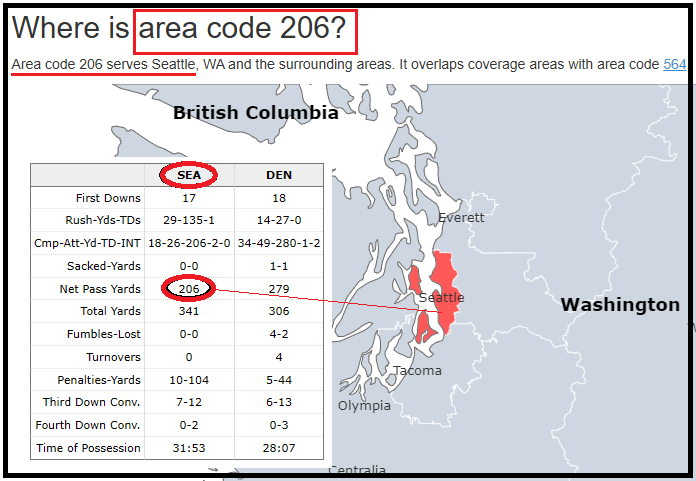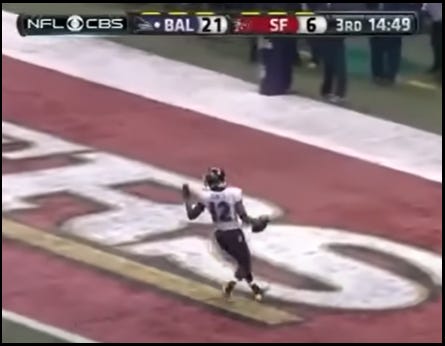Seattle, Super Bowl 48, and our Next Statistical Miracle
The Tim Tebow "316" Game Has a Worthy Rival
This is the third post in a series that begins here.
In second and our previous post, we discussed a meta sync involving 30 straight Super Bowls and pointed out a little gem that went entirely unnoticed: In a Monday Night Football game in 2013, Drew Brees of the New Orleans Saints threw for exactly 144 yards in a game against the Seattle Seahawks—on what just happened to be Seattle’s 144th birthday, when Seattle was exactly 12 × 12 × 12 months old.
We have much more to say about Seattle’s Super Bowl–winning season. Through the 12s, Super Bowl 48 reveals how much we can miss when we treat synchronicity superficially. But before we head that direction, let’s revisit the Tim Tebow 316 story—and highlight other sync data that was completely overlooked.
SUPER BOWL 48
End of the Meta Line: Irresistible Force, Meet Immovable Object
Contested between the Denver Broncos and the Seattle Seahawks, Super Bowl 48 was one of those irresistible force meets immovable object situations.
By then, Peyton Manning was two years into his Denver Broncos era. The 2013 Broncos were legendary for their high-octane offense, setting NFL records for both most points in a season (606) and most passing yards (5,572).
On defense, the 2013 Seattle Seahawks were just as historically terrifying. The Twelves’ Legion of Boom defense led the league in points allowed (231), yards allowed (4,378), and takeaways (39). It was the first time a team had led all three categories since the 1985 Chicago Bears.
As 200 million fans settled in to watch the game, the Broncos started on offense. Peyton Manning set up for the Bronco’s first play, having thrown for exactly 400-yards in his previous game…
What followed was the fastest scoring play in Super Bowl history. And more, as we now know. The play below also marked the completion of a meta sync spanning 30 consecutive Super Bowls, whose expected random appearance falls somewhere in the “once every trillions of years” neighborhood.
Meta Foreshadowing?
We now see evidence that synchronicity events sometimes foreshadow later episodes. So now we ask: was the 30-year Super Bowl streak meant to end with three straight 12-related safety plays in order to foreshadow Seattle’s—and the Twelves’—triumph in Super Bowl 48?
Once this possibility is seriously considered, the city’s age on the night the Twelves shattered the world noise record becomes part of the foreshadowing equation. Another passing metric syncs perfectly with the present moment: New Orleans’ 144 passing yards reflect Seattle’s 144th birthday at the time of that Monday Night Football game. How fitting that the city was exactly 12 × 12 × 12 months old that same night. When the Twelves broke the world crowd noise record.
This birthday data—and the triple safety set—legitimize the idea that the meta sync may have been meant to foreshadow Seattle’s fate, through their bizarrely rare emphasis on the number 12.
Other data support this, too, albeit in more ancillary ways.
Doubling Down 12 Style: What are the Odds?
As noted, the third safety play above didn’t just close out our trio of 12-based safeties by happening 12 seconds into Super Bowl 48.
The player who "scored" was Denver’s Knowshon Moreno—the 12th overall pick in the 2009 NFL Draft.
This on the first play after Super Bowl 48’s opening kick-off. At the very start of the greatest game in Seattle Seahawks and the Twelves’ history.
When we consider just the timing of this safety play, the big statistical question becomes: how often—in the league’s 16,000-plus game history (probably closer to 18,000)—have teams scored exactly 12 seconds into the first or second half of any NFL game?
We don’t care about other iterations, like 11 or 13. Only 12s count in this conversation. Really fast scores usually won’t.
When we look at both halves, it seems this happens about once every 8,000 games per half. But to give chance the benefit of the doubt, let’s double that frequency. So, on average, NFL teams score exactly 12 seconds into either half about once every 4,000 games.
We frame things this way because the same thing happened in the second half in Super Bowl 48.
Seattle’s Percy Harvin scored exactly 12 seconds into the third quarter—this time on a touchdown.
Harvin delivers our next trifecta of 12s here, by the way. A few years earlier, he scored another touchdown 12 seconds into the second half during an October 17, 2010 game between Minnesota and Dallas. A couple of years later, Harvin scored a touchdown 12 seconds into a game on September 30, 2012, between Minnesota and Detroit.
Now we’re really starting to cook.
If the meta sync was meant to foreshadow Seattle at its very end through 12-related symbolism, then adding a second very rare 12 in Super Bowl 48 would be a very good way to reinforce that intent—especially when the second 12er has the exact same 00:12 time signature that linked the first rare play, the safety, to the meta pattern. This interpretation isn’t contrived. It reflects how we humans are wired to think, when such patterns both can and need to be prosaically explained. Given the odds involved, we would likely insist that the meta pattern was a set up, since there’s no way it could have happened due to random happenstance.
The Sensational 00:12 Double Play
Meta plan or not, these are two of the plays that caught everyone’s attention in Super Bowl 48. They got people’s attention because they were so sensational—not because of the 12s.
Of course, we can be sure some Seahawks fans noticed the relevance of the common 00:12 time signatures. But we don’t talk about those things too much, do we? Little wonder that only some Twelves noticed this back then. And that’s a pity, because this data adds so much local richness to their finest hour.
Of those who knew, how many asked themselves the scientific question—the one we rarely allow ourselves to ask? These two plays amount to very science-friendly data. We have at least 16,000 games to consider and fully transparent data points that are perfectly testable. Our sync setting is ideal, unlike the one where Carl Jung allegedly saw that beetle appear on his windowsill.
There are two scientific questions:
How often do NFL games feature scoring plays that occur exactly 12 seconds into both halves?
And, to the null hypothesis test and that sacred phrase, p = 0.05:
Does this kind of pairing appear at least once every 20 NFL games—a few times each month during the NFL’s regular season?
We all know the answer to the second question which is the only thing that matters scientifically.
Crunching the numbers anyway: at that common 1-in-4,000 rate, we’re looking at a pairing we should expect never to witness in our lifetime. Only one out of every 16 million NFL games would feature this combo. What happened in Super Bowl 48 is the kind of anomaly we might expect once every 56,000 NFL seasons—at the current pace of 285 games per year. Or, if we stick to Super Bowls only, about once every 16 million years.
Statistically speaking, as far as the 12s are concerned, this pairing leans heavily in favor of the meta pattern foreshadowing something—rather than being chalked up to random happenstance.
Russell Wilson and the 206
Then there's the curious case of Seattle’s star quarterback, Russell Wilson.
Wilson, number 3, was the 12th player drafted in the 3rd round of the 2012 NFL Draft. In Super Bowl 48, he threw for exactly 206 yards.
Seattle’s telephone area code is 206—a code that, for the longest time, covered the entire state of Washington and the wider Seahawks fan base.
Redundancies
Having been at this for a while, I’ve noticed that certain kinds of meaningful connections tend to reappear—sometimes within a single synchronicity, and other times across multiple syncs.
We’ve seen such reduancy here and elsewhere with various passing yardage stats.
That’s exactly what caught America’s attention in what became known as the Denver–Pittsburgh John 3:16 game. Five different 316s were noted. More redundancy.
In the 30-Super Bowl meta sync, I noted what I called the adjacency effect. Three macro syncs were connected in this striking way. So was Super Bowl 48, which now looks like another major macro sync—through multiple data points that are clearly significant, relevant, and highly improbable.
Before we go on to the quiet climax of Super Bowl 48, I’ll briefly note another recurring redundancy: data points that concern what I will call compelling pairings.
We just saw one—two scoring plays that both began exactly 12 seconds into both halves of Super Bowl 48. Hard to unsee that connection once it clicks, isn’t it? That’s what I mean by compelling.
The Super Bowl 47 safety occurred on a play that began with exactly 12 seconds left in the game—only to be followed by another safety that began exactly 12 seconds into the very next Super Bowl. Once you see the wider pattern, that kind of 12-based symmetry is hard to ignore.
Super Bowl 47 also featured a touchdown on the very first play of the second half. (Just a few minutes before the now-infamous 34-minute blackout hit, on the 34th day of 2013, in a game where the victorious Baltimore Ravens scored exactly 34 points.)
So now we have two consecutive NFL games, each with a touchdown on the opening play of the second half. How often do two back-to-back games feature that kind of pairing?
Less than 1 in 20, that’s for sure.
Jacoby Jones scored his touchdown 11 seconds into the second half of Super Bowl 47. Not quite the same as Percy Harvin’s 12. As if to make up for things, and encourage the pairing way of thinking: Jones was wearing number 12 at the time.
Harvin was wearing number 11 when he scored his second-half TD in the next Super Bowl.
Are we being encouraged to consider Jones and Percy Harvin as another pair?
A few years earlier, Jones scored a touchdown 12 seconds into a regular season game. So did Percy Harvin, as noted.
Such thinking also recalls Super Bowl 48, where Percy Harvin’s Super Bowl touchdown appears to be only the second time in NFL history that a player has scored exactly 12 seconds into a second half.
That earlier score?
As noted, it was scored by Percy Harvin.
At the time, he was wearing the number 12.
As Harvin was when he scored a touchdown 12 seconds into a Minnesota-Dallas game.
Digging Deeper
One takeaway from this post goes as follows: it can pay to look closer, when it comes to episodes that already seem very well-synced for whatever compelling reasons.
That lesson continues in the next post.
For now, as far as synchronicity goes, let’s call this pairing for what it is.
The safety play that began Super Bowl 48 and the touchdown that opened the third quarter are what we sometimes call "softballs" in modern culture.
I’m talking about the kind of in-your-face syncs that are basically impossible not to notice and contextually understand. Tim Tebow’s famous touchdown was another big-time softball. Once the 316s started showing up, millions of fans immediately recognized the meaningful connection—back to that time when Tebow wore John 3:16 under his eyes. One didn’t need to be a Biblical scholar to see that relevance clearly. They just needed to know the Tebow backstory which, in 2011, was hard to miss.
Super Bowl 48’s two 12-second scoring plays are just as glaringly relevant—especially to the Seattle Seahawks and their fan base. One doesn’t need to be a stats guy to see the connection.
That said, if we stopped here, we’d only be telling the smaller part of Super Bowl 48’s story.





